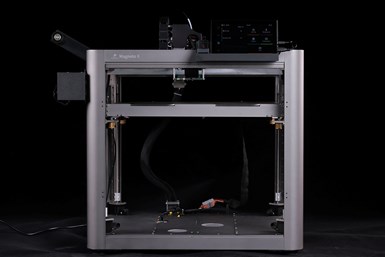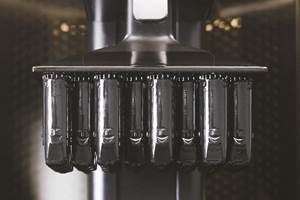Magneto X Desktop 3D Printer Features Linear Motor System
Peopoly’s Magneto X is said to offer improved accuracy and reliability at higher print speeds, as well as a more streamlined motion system compared to printers that rely on belts and stepper motors.
The Magneto X offers a more streamlined motion system compared to those reliant on belts and stepper motors. Photo Credit: Peopoly
Peopoly’s Magneto X fused filament fabrication (FFF) 3D printer is designed to offer new standards for speed, precision and reliability. The printer has been designed from the ground up to enhance and optimize the performance of desktop 3D printing. Based on familiar FFF technology, the Magneto X goes beyond traditional belts and pulleys, enabling high-speed, great surface finish and precise 3D printing at the desktop — all powered by magnets.
The Magneto X features Peopoly’s MagXY magnetic levitation linear motor system for the X and Y axes, achieving unprecedented repeatability of 3 microns. This motion system does away with belts and pulleys, thereby eliminating common artifacts such as ringing and vertical fine artifacts (VFA). In contrast to traditional stepper motors (which can suffer from reduced precision under heavy loads), the MagXY system remains cool, sustaining its accuracy through a true closed-loop system with position feedback.
The MagXY also offers a more streamlined motion system compared to those reliant on belts and stepper motors. Traditional belts not only require periodic tension adjustments but also experience wear and tear, which can complicate maintenance. In contrast, the clean, simplified design of the MagXY linear motor system expedites tasks like extruder replacement, as there are no belts to disconnect or obstruct access. Its lower rail friction also enhances useful life span and reduces the need for frequent calibration, ultimately lowering downtime and saving costs for professionals in the long run.
The printer offers optimized performance for speed and extrusion. Magneto X achieves print speeds of up to 1,200 mm/sec. and a maximum acceleration of 22,000 mm2/sec., made possible by its low-friction linear motor. However, speed is just one aspect of reliable, high-quality printing. The other key factor is the extrusion system’s ability to extrude plastic quickly and consistently. Magneto X’s Lancer extruder delivers an extrusion force of 90 N and a filament speed of 30 mm/sec. Its variable-length melt zone enables a maximum flow rate of up to 60 mm3/s, facilitating rapid printing without sacrificing quality. The printer uses a standard E3D V6 volcano-style nozzle, ensuring easy replacement and broad filament compatibility.
The Lancer extruder also has a load cell sensor and a filament runout sensor. Initially, the load cell sensor calibrates the four independently driven Z-axis rods to level the build plate. Following this, the extruder performs a 48-point mesh measurement on the heated build plate, capturing detailed data for calibration. Magneto X then uses this mesh data to set the Z-offset, ensuring precise auto leveling. The filament sensor continuously monitors material levels to prevent print failures due to material depletion.
Magneto X offers a 400 x 300 x 300-mm build volume and features four independently driven Z-axes for enhanced stability and leveling accuracy. It is equipped with a 300°C hot end and includes 0.4 mm copper and hardened steel nozzles. These specifications make it compatible with a variety of materials such as PLA, PETG, ABS, ASA and Nylon-Carbon Fiber.
Running on Klipper firmware and featuring a 7” IPS touchscreen, the printer offers an intuitive user interface. It supports Orca Slicer, PrusaSlicer and Cura, and provides multiple connection options such as WiFi, Ethernet and SD card offline mode. Peopoly supports the open-source community and sponsors OctoPrint and Orca Slicer. Magneto X operates on Klipper firmware with a transparent code base. It neither requires a network connection to function nor sends or stores data in the cloud, ensuring operability alongside full security and IP protection.
Related Content
How to Build 10,000+ Shot Molds in Hours
Rapid tooling isn’t so rapid when it takes days to 3D print a metal mold, and then you still must machine it to reach the necessary tolerances. With Nexa3D’s polymer process you can print a mold in hours that is prototype or production ready and can last for more than 10,000 shots.
Read More3D Printing with Plastic Pellets – What You Need to Know
A few 3D printers today are capable of working directly with resin pellets for feedstock. That brings extreme flexibility in material options, but also requires greater knowledge of how to best process any given resin. Here’s how FGF machine maker JuggerBot 3D addresses both the printing technology and the process know-how.
Read MoreActivArmor Casts and Splints Are Shifting to Point-of-Care 3D Printing
ActivArmor offers individualized, 3D printed casts and splints for various diagnoses. The company is in the process of shifting to point-of-care printing and aims to promote positive healing outcomes and improved hygienics with customized support devices.
Read MoreAM 101: Digital Light Synthesis (DLS)
Digital Light Synthesis (DLS) is the name for Carbon's resin-based 3D printing process. How it works and how it differs from stereolithography.
Read MoreRead Next
At General Atomics, Do Unmanned Aerial Systems Reveal the Future of Aircraft Manufacturing?
The maker of the Predator and SkyGuardian remote aircraft can implement additive manufacturing more rapidly and widely than the makers of other types of planes. The role of 3D printing in current and future UAS components hints at how far AM can go to save cost and time in aircraft production and design.
Read More3D Printing Brings Sustainability, Accessibility to Glass Manufacturing
Australian startup Maple Glass Printing has developed a process for extruding glass into artwork, lab implements and architectural elements. Along the way, the company has also found more efficient ways of recycling this material.
Read More4 Ways the Education and Training Challenge Is Different for Additive Manufacturing
The advance of additive manufacturing means we need more professionals educated in AM technology.
Read More








.png;maxWidth=300;quality=90)















